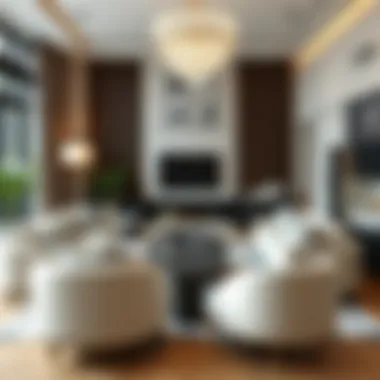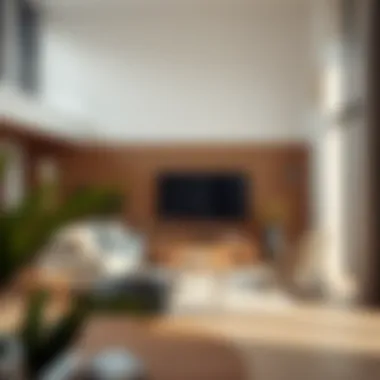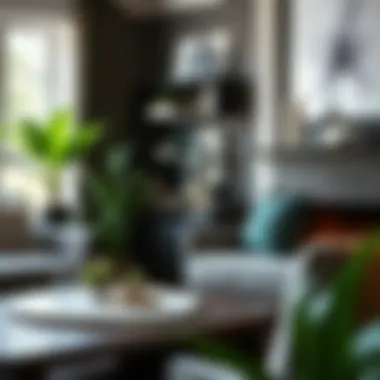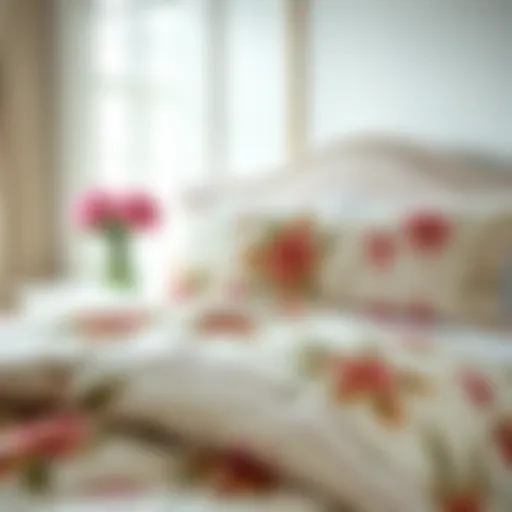Mastering House Decor Planning for Stunning Spaces


Intro
Decorating your home can feel like navigating a maze—many options, dead ends, and, at times, overwhelming choices. With the right know-how, however, planning your house decor can become a straightforward and enjoyable process. This guide endeavors to map out the essential components of decor planning, blending aesthetics with practicality. Here, we will delve into various themes including current design trends, thoughtful furniture selection, and budget considerations, ensuring you find a style that resonates with your personality and lifestyle.
The importance of creating a harmonious living space cannot be overstated. It sets the mood and reflects who you are as an individual. Whether you’re an aspiring interior designer, a homeowner searching for freshness, or a decor enthusiast looking for new ideas, this guide will serve as a valuable compass to help you steer through the intricate world of home decoration.
Design Trends
To understand modern decor, one must grasp the current trends shaping our living spaces. It’s more than just following the latest fads; it's about identifying elements that foster comfort and functionality in your homes. Let’s explore the latest in furniture styles and how to seamlessly incorporate these trends.
Current Trends in Furniture Styles
Today's furniture design often emphasizes minimalism paired with functionality. For instance, the Scandinavian style continues to capture hearts with its simple lines, light woods, and functional elements. Alternatively, you have the resurgence of Art Deco, which offers luxurious fabrics, bold colors, and geometrical patterns. Here’s a quick overview of some prominent trends:
- Sustainable Materials: Many are now opting for eco-friendly options, such as bamboo or reclaimed wood, which not only aids the environment but also brings character to spaces.
- Multipurpose Furniture: Think sofas that can convert into beds or coffee tables with storage. These pieces are perfect for maximizing smaller spaces.
- Bold Colors: Rich jewel tones and unexpected color pairings are revitalizing spaces, encouraging personality and vibrancy.
How to Incorporate Trends into Your Space
Incorporating these trends into your home doesn't require a complete overhaul. Start by selecting a few key pieces that speak to you. For example, if Scandinavian design resonates, consider a clean-lined sofa and add plush textiles for warmth. Layering textures is crucial here; mixing materials like leather, wood, and soft fabrics offers depth.
A simple way to stay on-trend is by updating decor accents – switch out throw pillows or revitalizing your art selections. The use of wall-mounted storage is on the rise, allowing for a blend of display and practicality.
“The right decor doesn’t just beautify a space; it must serve function while reflecting the essence of the inhabitant.”
Buying Guides
When it comes to purchasing furniture, the choices can seem endless. But the key is knowing what fits your space and budget. Let’s examine how to choose pieces that enhance functionality while ensuring you get the best bang for your buck.
Choosing the Right Furniture for Different Rooms
Every room has its own vibe and purpose, therefore the furniture should align accordingly. For a living room, look for comfortable seating with good support, ideally set around a focal point, like a fireplace or entertainment unit. In bedrooms, prioritize pieces that offer storage, like beds with drawers or nightstands that serve double duty with shelving.
- Dining Rooms: Oversized tables can dominate spaces; choose sectional alternatives like a round table for better flow.
- Kitchens: Focus on durable materials that stand up to wear and tear, especially in high traffic areas.
Tips for Assessing Quality and Value
Not all furniture is created equal, so know what to look for:
- Materials: Hardwood often beats softwood for durability. Look for solid construction that hugs tight corners and doesn’t wobble.
- Finish: Pay attention to the quality of finishes on surfaces. A well-done stain or veneer can elevate an item immensely.
Before purchasing, read reviews or visit a store to see and feel the product. And remember to always think about longevity; investing in quality furniture pays off over time.
By keeping your finger on the pulse of design trends while remaining mindful of your needs and budget, you can transform your home into a space that not only looks stunning but functions exceptionally well too. Further, consistent attention to detail, and understanding how different elements play together will lead to the creation of a cohesive environment that feels like home.
Intro to House Decor Planning
Planning your home decor isn't just a fun activity; it's a fundamental step to creating spaces that feel like true sanctuaries. With the right approach, you can turn any dull, lifeless room into an inviting and vibrant environment. This planning process acts as a roadmap, guiding homeowners, designers, and DIY enthusiasts alike through essential choices that influence the overall aesthetics and functionality of a home.
One might wonder, what makes decor planning such a crucial endeavor? The answer lies in the harmonious blend of elements that decor encompasses. From selecting styles and colors to arranging furniture and adding finishing touches, each aspect demands thoughtful consideration. A well-planned decor not only enhances the visual appeal but also reflects the personality and lifestyle of the inhabitants. Think of it as a canvas where each brushstroke contributes to the final masterpiece.
Benefits of Decor Planning
- Cohesion and Harmony: A structured plan fosters a unified look across your space. Every piece will feel like it belongs, rather than haphazardly thrown together.
- Maximized Functionality: With careful space assessment, layouts can be created that facilitate smoother traffic flow and improve everyday living.
- Emotional Well-being: A thoughtfully designed space can evoke specific feelings and moods, making it easier to unwind or stay productive as needed.
Key Considerations
While getting lost in the excitement of decor choices is tempting, there are several considerations to keep in mind to navigate the planning effectively.
- Budget Constraints: Knowing your financial limits can shape choices significantly. It ensures that you pick selections that fit within your means while still achieving the desired effect.
- Space Requirements: Each room comes with its unique quirks. Taking proper measurements and noting any limitations ensures that your selections will work seamlessly.
- Preferred Styles: Without an understanding of personal taste, it's easy to fall into trends that may not resonate long term. Recognizing what you enjoy will help steer decisions that ultimately lead to a satisfying outcome.
The process of house decor planning is akin to piecing together a puzzle where all components must align for the complete picture to emerge. By paying attention to details and thoughtfully engaging with each element, you open the door to creating a space that is both charming and authentically yours. As we navigate through this guide, each section will delve deeper into the nuances of decor planning, ensuring you are well-equipped to embark on this creative journey.
Understanding Your Decor Style
Understanding your decor style is fundamental when it comes to planning a home’s aesthetic. It sets the tone for every room and helps ensure that the spaces within your home are a coherent blend of tastes and preferences. Recognizing your style can simplify decision-making processes as you choose furniture, colors, and decorative elements. Moreover, aligning with your decor style fosters a sense of comfort, making a house feel more like a home.
Exploring Different Decor Styles
Modern
Modern decor is characterized by clean lines, minimalistic forms, and a focus on function over ornamentation. The key characteristic of modern decor is its focus on simplicity, often employing a neutral color palette with bold accents. This style is popular among homeowners who enjoy a clutter-free environment and appreciate sleek designs. One unique feature of modern design is its integration of technology into everyday living spaces, bringing both aesthetic appeal and functionality. However, while modern spaces can create a calming atmosphere, they may feel sterile to some, as the lack of intricate details can sometimes come off as cold.
Traditional
Traditional decor reflects historical influences and incorporates rich colors, ornate furnishings, and classical architecture. This style draws on the past, featuring traditional elements like crown moldings, antique furniture, and a variety of textures. Its key characteristic is a sense of warmth and timelessness, making it a popular choice for those seeking a cozy, inviting space. The unique feature of traditional decor is the emphasis on symmetry, which can promote balance and harmony throughout the design. Though traditional decor may sometimes feel overly formal, its comforting presence often connects families with their heritage.
Bohemian
Bohemian style is marked by its eclectic mix of colors, patterns, and textures, representing a harmonious blend of cultures and personal stories. The key characteristic of Bohemian decor is its free-spirited essence, allowing for creativity and individuality in design choices. This style works exceptionally well for those who appreciate a relaxed, casual environment filled with personal artifacts and unique treasures. One unique feature of the bohemian style is layering—not just textiles, but patterns and colors which can create depth. While bohemian decor can sometimes appear chaotic, thoughtful layerings can result in a vibrant showcase of curated objects.
Industrial
Industrial decor draws inspiration from urban warehouses and factories. It highlights raw materials such as exposed brick, metal, and wood. The defining characteristic of industrial design lies in its rugged, unfinished aesthetic. This style is favored in urban settings but can inspire anyone who enjoys a more laid-back, authentic feeling in their home. A unique feature of industrial decor is the use of repurposed items, such as old factory pieces or vintage finds. While this style can offer an edgy charm, it may not cater well to those seeking warmth or softness in their living spaces.
Minimalist
Minimalism focuses on the principle of "less is more," often characterized by simplicity, decluttered spaces, and a limited color palette. The key characteristic of minimalist decor is its emphasis on simplicity and functionality, promoting a lifestyle that values fewer possessions. This approach is beneficial for individuals who prefer a serene and organized environment. Unique to minimalist style is the ability to evoke calm and clarity, making spaces feel expansive. However, its starkness might not suit everyone's taste, as some might find it too austere or devoid of personality.
Identifying Personal Preferences
Cultural Influences
Cultural influences shape personal decor styles by merging inherited customs and local traditions into design choices. This aspect is essential as it captures the uniqueness of your environment and personal experiences, creating a distinct ambiance in your home. The key feature here is how cultural elements can instill a sense of belonging. Whether it's Asian-inspired Zen gardens or rustic Italian furnishings, these influences paint a picture of who you are. However, a challenge might arise if different cultural elements clash, potentially leading to a disjointed decor presentation.
Emotional Factors
Emotional factors are pivotal when identifying decor styles, as they reflect what makes you feel comfortable and at home. These might include memories associated with particular colors, textures, or designs. One significant aspect of emotional factors in decor is how specific styles can evoke feelings of comfort, nostalgia, or even inspiration. For instance, brighter tones might uplift your mood, while softer hues encourage relaxation. Still, relying solely on emotional responses can sometimes lead to impulsive buying, which might not be practical.
Practical Needs
Practical needs incorporate functionality into decor choices, ensuring that the selected styles meet everyday requirements. This aspect could range from selecting furniture that accommodates family gatherings to choosing durable materials suitable for pets and children. The key characteristic of considering practical needs is the balance between beauty and utility. While some styles may look great, they must additionally fulfill the necessary roles that make day-to-day living manageable. Ultimately, impractical choices can lead to dissatisfaction, as aesthetics alone cannot compensate for a lack of functionality.
Space Assessment and Planning
Understanding the intricacies of space assessment and planning is fundamental to achieving a well-decorated home that marries aesthetic appeal with everyday functionality. This stage lays the groundwork for all subsequent decor decisions, ensuring that the choices made resonate with both personal taste and practical needs. Without a thorough assessment, one might find themselves in a situation where beautiful decor clashes with how a space is actually used.
Measuring Your Space
Room Dimensions
Room dimensions play a critical role in determining how a space can be utilized effectively. When measuring, it’s not just about square footage; it’s about understanding the proportions and layout that will give life to your design vision. Good measurements help avoid awkward situations, like purchasing a sofa that won’t fit through the front door or arranging a table that leaves no space to walk around.
Unique features of room dimensions can include irregular shapes or ceiling heights that affect how furniture is arranged or what types of decor will fit harmoniously within. For instance, a low ceiling may benefit from lighter colors and lower-profile furniture to avoid feeling cramped, while spacious ceilings may invite grander furniture pieces or artistic light fixtures.
Key Features
Key features of the room, such as architectural details or elements like windows and doorways, heavily influence the decor planning phase. Understanding where these features are located can also determine furniture arrangement and traffic patterns throughout the space. For example, large windows bring natural light but can also dictate furniture placement to maintain flow without blocking those views.
Considering these features is essential. They are unique characteristics that might make certain styles more suitable than others. In an instance where crown moldings or vintage fireplace mantels exist, integrating decor that harmonizes with these elements can elevate the overall aesthetic.
Natural Light Sources
The presence of natural light can dramatically transform a space and plays a significant role in the overall decor scheme. Rooms basking in sunlight often provide a warm and inviting atmosphere, whereas dimly-lit areas may feel cold or constricted. The optimal use of natural light should be a priority in decor planning.
Positioning mirrors or choosing lighter paint colors can enhance light reflection, leading to a more spacious feel in areas with limited sunlight. Unique to natural light is its ability to change throughout the day, casting different shadows and illuminations. Hence, planning decor arrangements that adapt to evolving light conditions can enhance a room’s appeal.
Creating Functional Layouts


Furniture Placement
Furniture placement can make or break the flow and comfort of a room. It's not just about aesthetics; it's about creating a space that feels inviting and intuitive. When planned correctly, furniture invites people to gather and communicate, making the room livable.
A key aspect of furniture placement lies in understanding the purpose of the space and how it will be used on a daily basis. Will it be a gathering place for family, an area for relaxation, or a combination of both? Tailoring the placement accordingly can lead to enhanced usability and comfort.
Traffic Flow
Traffic flow is an essential consideration that often gets overlooked. This refers to how people move through a space, from entryways to key activity areas. A well-thought-out traffic flow ensures everyone can navigate a space without unnecessary obstacles.
When individuals travel around frequently used areas, such as around a coffee table or navigating from the kitchen to the dining area, it’s beneficial to ensure that foot traffic is not obstructed. This can involve strategic furniture placement, where larger pieces are positioned towards the wall or away from pathways.
Zoning Areas
Zoning areas is another effective way to delineate specific functions within larger spaces. It helps create organized layouts while allowing flexibility in how one uses each area. For instance, you may opt to zone a living room to have a reading nook and a socializing space, creating variety within a singular environment.
The distinctive feature of zoning is its capacity to leverage furniture and decor to demarcate areas without the physical barriers of walls. Utilizing area rugs to separate regions can be an intuitive and visually appealing approach. Overall, effective zoning enhances functionality and aesthetic harmony in home decor.
Color Theory and Application
Color theory serves as the backbone of any stylish home decor. Choosing the right colors not only enhances the beauty of a space, but also creates an environment that reflects your personality and mood. Understanding how colors interact can help create a livable space that feels cohesive and inviting. The way colors are combined can evoke responses that influence everything from the comfort level of a home to the function of its rooms. By grasping specific color principles, you can more effectively gather ideas that resonate with your vision for your home.
Understanding Color Psychology
Color Wheel Basics
The color wheel is a fundamental tool in the world of design. It organizes colors into a circular format that helps illustrate their relationships. The wheel is made up of primary colors, secondary colors, and tertiary colors. This basic structure is essential because it allows decorators to see which colors work harmoniously together and which ones may clash.
One key characteristic of the color wheel is its clarity—it makes understanding color relationships simple. This simplicity makes it a beneficial choice for exploring color combinations for any space.
A unique feature of the color wheel is the creation of analogous and complementary color schemes. Analogous colors are next to one another, while complementary colors are opposite. This can be an advantage when trying to create soothing or stimulating environments, depending on your goals. However, the disadvantage may lie in oversaturation, where too many colors can overwhelm the senses.
Warm vs. Cool Tones
Warm tones are typically associated with energy and excitement, while cool tones bring a sense of calm and serenity. The distinction between these two types of colors greatly influences interior aesthetics. Warm colors like reds, oranges, and yellows can make a space feel inviting and cozy but may also heighten emotions—something to consider for bedrooms or relaxation spots.
The key characteristic that makes warm tones popular is their ability to create a sense of intimacy. They shine in social spaces where conversations flourish. However, overuse can create a chaotic atmosphere that might be too stimulating.
Cool tones including blues, greens, and purples tend to promote tranquility. They are often favorites in spaces where relaxation is key. While their serene nature makes them a great choice for bedrooms or studies, they can sometimes feel too cold if not balanced with warmer accents.
Emotional Responses to Colors
Colors evoke emotional responses that can change the dynamics of a space. For instance, blue can often produce feelings of calmness and tranquility, making it ideal for places such as bedrooms or bathrooms. In contrast, red can stimulate the appetite and energy levels, making it ideal for dining rooms.
The key characteristic here is the psychological impact colors hold. Having an awareness of these responses is beneficial for achieving a desired ambiance. The unique feature of utilizing emotional color responses is that it allows homeowners to tailor their spaces to support their chosen activities, be it relaxation or socializing. However, neglecting individual emotional associations with colors might lead to a mismatched design outcome.
Choosing a Color Palette
Selecting a color palette can be tricky. A harmonious palette is one that creates a unified look across a space while still allowing for diversity. There’s a beauty in the delicate balance that comes from blending various hues effectively.
Monochromatic Schemes
A monochromatic scheme uses variations in one color. This approach can create a sense of serenity and cohesion within a space. Its key characteristic is simplicity; an entirely monochromatic look can often be both soothing and sophisticated.
In a practical sense, it stands out as a popular choice because it allows for personal expression through shades and tints. However, too much of a single color can make a room feel flat—something to keep in mind when planning how to incorporate your chosen shades.
Complementary Colors
Complementary colors are ones that are opposite each other on the color wheel. This aspect of color theory can create striking visuals and draw attention to key features within a space. The boldness of these pairings makes them a beneficial choice for emphasizing accents and areas you’d like to highlight.
The unique feature of complementary colors is that they bring vibrancy and movement to a decor. However, one must also be cautious, as too much contrast might lead to a chaotic or jarring visual experience.
Accent Colors
Accent colors are used to add pops of interest against a more neutral backdrop. They highlight areas of focus and can bring life into a space. The key characteristic of accent colors is their ability to bring a room to life without overwhelming it. This makes them essential for maintaining focus on desired elements in your decor.
The unique value found in strategically choosing accent colors is that they can be easily changed when a refresh is needed—all without the commitment of repainting entire walls. However, an overzealous use of accents might make a space feel disjointed.
Understanding color theory and its practical applications is fundamental for anyone interested in crafting aesthetically pleasing environments. The right colors and combinations can enhance the feel, functionality, and beauty of your home.
Furniture Selection and Sourcing
When it comes to orchestrating a memorable atmosphere in your home, furniture selection isn't just an afterthought; it's the backbone of décor planning. The right pieces do more than just fill a space; they narrate your story and enhance the functionality of your living environment. Whether you lean towards sleek minimalism or eclectic mixtures, understanding how to evaluate and source your furniture can elevate your home’s aesthetic and utility.
Evaluating Quality and Style
Materials and Durability
The choice of materials can make or break your furniture experience. Investing in durable materials like hardwood or metal can offer long-lasting beauty and resilience. Such materials also tell a story of craftsmanship, which is often appreciated by discerning homeowners. On the contrary, softer woods or certain plastics might seem affordable but often bear the risk of scratches and wear over time. It's essential to weigh the longevity of these choices when shaping your home's budget and style.
Some structures have a unique cachet; for instance, reclaimed wood carries the marks of its past, adding character while supporting sustainable practices. However, you must also factor in the level of care these materials require. A focus on durability might pay off in the long run, as your pieces withstand daily use without turning into eye-sores.
Design Consistency
Design consistency plays a significant role in maintaining a harmonious look in your home. When selecting furniture, keeping a consistent style can help create a unified space that feels planned rather than chaotic. Each piece should relate to the others, forming a cohesive visual language. For instance, if your home leans towards a Scandinavian aesthetic, a stark, minimalist coffee table accentuates rather than clashes with the overall atmosphere.
Mass-produced items can often be tempting due to their affordability, but many lack the distinctive style that bespoke pieces can offer. Unique choices, such as custom builtins or artisanal materials, help foster a refined look but might come with a heftier price. It's a balancing act between individuality and cohesion.
Scale and Proportion
Size matters when it comes to furniture selection. The scale of your furniture should be proportionate to the dimensions of your rooms. Oversized sofas may dwarf a tiny living area, while delicate chairs could vanish in a large open space. This aspect is crucial not only for aesthetics but also for functionality.
For instance, something like a grand sectional can seem inviting in a vast room but may look overwhelmingly large in a snug apartment. On the flip side, lighter pieces might create an airy feeling in smaller spaces making them feel roomier. Achieving the right scale can transform a room from cramped to inviting.
Sourcing Options
Retailers vs. Custom Pieces
The choice between retail options and custom pieces should align with your needs and budget. Retailers often provide a quick solution, with ready-to-use inventory and commonly accepted styles. However, they may lack the personality that a custom piece delivers. Custom items can be tailored to your exact specifications but may involve a longer wait and a higher price point. It’s essential to consider how each fits into your overall plan.
Online Marketplaces
In the digital age, online marketplaces open up a whole new avenue to explore furniture options. Sites like Wayfair or Etsy feature diverse offerings from various styles, allowing for easy comparison. This flexibility can lead to unexpected finds that perfectly fit into your scheme. However, the challenge lies in determining the quality without seeing the items firsthand, so always look for reviews or return policies to safeguard your purchases.
Local Artisans
Supporting local artisans can be a rewarding avenue both creatively and ethically. Such pieces often provide more than just functionality; they encapsulate local culture and craftsmanship. You may discover unique items that tell a story and serve as conversation starters in your home. The downside? Well, they can sometimes come with a premium price tag and may require you to be more patient in sourcing. Still, when you want something that stands out, local craftsmanship is often worth it.
In summary, thoughtful furniture selection and strategic sourcing are crucial to crafting a well-designed home environment. From quality and style to where you find pieces, every aspect matters in creating an inviting space that resonates with your personality and meets your practical needs.
Incorporating Accessories and Textiles
In the world of home decor, accessories and textiles are the finishing touches that bring a space to life, enhancing both its aesthetic and functional qualities. Think of them as the icing on the cake or the final brushstroke on a canvas. They fill in the gaps created by larger furniture pieces, add warmth, texture, and create layers that can completely transform the mood of a room. Instead of just throwing in a couple of throw pillows or a rug, it’s important to curate these elements strategically, considering their impact on the overall visual narrative.
Choosing Decorative Accessories
Artwork and Wall Decor
Artwork and wall decor play a pivotal role in setting the emotional tone of any space. One look at your walls and you can often gather insight into the personality of the home. This specific aspect goes beyond mere decoration; it’s a reflection of identity and taste. Artwork frequently acts as a focal point, drawing the eye and creating points of interest within the design.
The key characteristic of artwork lies in its ability to evoke emotions. Whether it’s a vibrant abstract piece or a tranquil landscape, the right artwork can enhance the atmosphere of a room significantly. When homeowners select pieces that resonate with them, it creates a sense of belonging.
However, there's a unique feature to consider: scale. An oversized piece can dominate a small room, while too many small pieces can make a spacious area feel cluttered. Achieving a balance is crucial, bearing in mind both the size of the artwork and the surrounding elements.
Advantages of thoughtful selection include personal connection and the enhancement of decor styles, whereas disadvantages could be over-personalization leading to limited appeal for guests.
Rugs and Textiles


Rugs and textiles contribute to a room's character by bringing in comfort and defining spaces within an open concept layout. They can outline seating areas, add warmth to cold floors, and provide a canvas for other decor elements. Textiles, ranging from curtains to cushions, enhance color palettes, while rugs can add a touch of luxury or a grounding effect depending on their texture and design.
Their key characteristic? Versatility. Rugs can easily be swapped out seasonally or with evolving personal styles without major overhauls to the room. In addition, they are practical, softening hard surfaces and making spaces more inviting.
Unfortunately, one of the unique features of rugs is maintenance. High-pile rugs look fantastic but require more cleaning than flatweave varieties. Hence, homeowners must weigh the aesthetic advantages against practicality. Still, the overall benefits of cozying up a space and adding visual layers can’t be overstated.
Plants and Greenery
Incorporating plants and greenery into your decor not only livens up a space but also helps purify the air, promoting health and well-being. A dash of nature enhances the overall ambiance of your environment, bridging the gap between the indoors and outdoors. This organic infusion adds freshness and can also reflect a certain lifestyle choice toward sustainability.
The key characteristic of plants is their developmental variability. They can serve as large statement pieces, like a tall fiddle leaf fig, or delicate accents with small succulents – they fit virtually anywhere! Popular choices often include low-maintenance options that suit busy lifestyles.
However, one unique feature of plants is their need for care. Not every plant thrives in the same conditions, so careful selection based on light and humidity is essential. Advantages include improved air quality and energy, but potential disadvantages involve commitment to their care and maintenance.
Layering Textures
Layering textures is integral to creating depth in a decor scheme. This approach elevates the visual interest and ensures that spaces feel well-curated rather than flat. The art of combining various textures leads to a richer experience within a room, pulling you in and inviting touch and exploration.
Combining Materials
When you mix materials like wood, metal, glass, and fabric, each unique texture tells its own story, adding dimension that a single material might lack. This distinct strategy can uplift a room from mundane to magnificent by introducing unexpected contrasts that engage the senses.
The beauty of this method lies in its flexibility; it allows homeowners to express personal tastes while keeping a cohesive aesthetic. However, there's a potential pitfall. Overly aggressive combinations can result in chaotic designs that confuse instead of enchant. The key is moderation and thoughtful curation.
Creating Visual Interest
By juxtaposing varied elements, you create focal points that can capture attention. A simple way to accomplish this might be placing a sleek glass vase next to a rustic wooden table, instantly providing contrast. Non-uniform items can draw the eye around a space, creating a sense of flow and inviting continued exploration.
One significant characteristic of visual interest is its invitation to touch and experience. It encourages interaction with a space, enhancing both visual and physical engagement. However, homeowners can watch out for the downside; excessive visual noise can overwhelm the senses rather than delight them. Striking a balance is paramount.
Balancing Hard and Soft Elements
Creating harmony between hard and soft elements is crucial in cohesive decor. While hard elements, like furniture made of wood or metal, provide structure and permanence, soft elements, such as cushions and throws, evoke warmth and comfort. Together, they create a balanced atmosphere that feels both secure and inviting.
One of the unique features here is how the right balance can dictate a room’s function. A more formal room may lean more heavily on hard elements, while a casual space might favor soft textiles. Achieving this balance fosters an inviting environment, making it all the more enjoyable to spend time in.
Lighting Considerations
Lighting plays a pivotal role in house decor planning. It goes beyond mere illumination. Good lighting can change the ambience of a room, highlight key features, and contribute significantly to how colors and textures are perceived. Selecting the right type of lighting is crucial to creating functional and aesthetically pleasing spaces. In essence, proper lighting enhances the overall decor, making a house feel warm, inviting, and alive.
Types of Lighting
Natural vs. Artificial
Natural light is a true gem; it’s like giving your space a big hug from the sun. This kind of lighting can breathe life into a room, making it feel open and airy. The golden hues of sunlight throughout the day can transform your living room into a relaxing oasis. However, it’s tricky to rely solely on natural sources, as it can be affected by weather, daytime, and building orientation.
On the flip side, artificial lighting offers reliability at any hour. Whether it's bright LED bulbs or soft incandescent lights, they allow you to mold the mood in any room according to your needs. This flexibility makes artificial light a popular choice in home decor. Still, it can sometimes feel too harsh or clinical if not thoughtfully applied.
Ambient Lighting
Ambient lighting is like the foundation of a well-built house; it sets the stage for everything else. It provides general illumination, creating a cozy backdrop in your home. This type of lighting enhances spatial perception and defines the functionality of a room. A well-implemented ambient lighting solution, such as ceiling fixtures or wall sconces, ensures that no corner of a room remains in the shadows.
But, if you overdo it, the result can leave your space feeling flat and uninspired. Striking a balance is key—too little ambient lighting can make areas feel cramped and stifling, while too much can overshadow other lighting schemes.
Task and Accent Lighting
Task and accent lighting play distinct but equally vital roles in home decor. Task lighting is practical, designed for specific activities. Think desk lamps illuminating a workspace or pendant lights hung over a kitchen island—they do wonders in facilitating everyday tasks. The key characteristic of task lighting is its focus; you want the light to shine where it’s needed most.
Accent lighting, meanwhile, is all about adding drama and flair. This could be a spotlight directed at a piece of artwork or a decorative lamp highlighting architectural features. It captivates attention and draws the eye, enriching the visual narrative. While both types serve different purposes, harmonizing them elevates the design.
Strategic Lighting Placement
Highlighting Features
Highlighting features in a space is a smart way to capitalize on your decor’s strengths. By strategically placing a light source on, say, a beloved sculpture or an intricately woven tapestry, you can turn a humble room into a gallery. The key here is to be intentional; ensure the light accentuates without overwhelming the feature it illuminates. Simple details, like properly angled lights, can make a world of difference.
Enhancing Mood
Lighting influences ambiance and emotion significantly. Whether it's bright lights that energize a space or softer hues that encourage relaxation, the ability to adjust lighting can help tailor your home to your daily needs. For evenings with friends, dimmable lights create warmth and conversation; for weekdays filled with tasks, brighter lights can stimulate focus.
Adjusting Brightness Levels
Adjusting brightness levels can really fine-tune the impact of your decor. Smart bulbs and dimmers provide versatility in how light interacts with space. Want to wind down after a long day? Dim the lights and light some candles. Need to tackle a project or read? Crank up the brightness. This adaptability allows you to shift between various moods and functions seamlessly, addressing the practicalities of everyday life while keeping it stylishly smart.
Lighting is more than mere illumination; it's about crafting the very atmosphere of your home.
Budgeting for House Decor
When embarking on a home decor journey, budgeting stands as a cornerstone of the process. Without a clear financial plan, the excitement of decorating can swiftly lead to overspending, leaving homeowners frazzled. A well-thought-out budget allows you to prioritize elements that speak to your personal style while ensuring that you remain within your financial limits. Moreover, it mitigates the stress that often accompanies decorating decisions, making each choice calculated rather than impulsive.
Setting a Realistic Budget
Identifying Necessary Expenses
Identifying necessary expenses is a vital first step in creating a decor budget. This involves distinguishing between what you truly need for your home and the various wants that may arise throughout the process. For instance, if you're laying the foundation for a living room, essentials like seating and lighting take precedence over decorative throw pillows or framed art. This focus narrows the financial scope, promoting responsible purchasing. A budget built on necessity can provide a** sense of accomplishment**, helping you gradually enhance your space without accumulating debt. However, one downside to this method is the risk of neglecting items you might later realize are important, like cozy textiles or vibrant artwork that can breathe life into your space.
Allocating Funds for Priorities
Once you've identified the necessary expenses, the next step is allocating funds for priorities. This part of budgeting brings clarity to which elements hold the utmost importance and deserve a larger slice of the financial pie. For instance, if you deem a stylish sofa more crucial than high-end lighting fixtures, it makes sense to funnel more funds toward that purchase. This thoughtful allocation can result in a space that feels well-coordinated and satisfying.
However, there's a double-edged sword to this strategy. Over-prioritizing certain decor elements might lead to underfunding other areas, like accessories or smaller feature pieces that could elevate the space significantly. Balancing these priorities takes a sharp eye and careful consideration of the overall aesthetic you're shooting for.
Planning for Future Needs
Planning for future needs is just as essential as outlining current expenses. This is about allowing a financial buffer for decor upgrades or unforeseen repairs, which always seem to crop up when least expected. Maybe your vision for a guest room evolves into a home office; knowing you have funds set aside for these shifts can keep your project on track.
An advantage of this foresight is that it cultivates adaptability. You won’t be stuck scrambling to find money should an unexpected decor opportunity or repair arise. On the flip side, overly conservative planning can lead to a stagnant environment. You might find yourself sticking to the same items for longer than necessary simply because of a tight purse string.
Cost-Saving Strategies
Thrift and Vintage Options
Thrift and vintage options are where creativity meets financial savvy. Finding unique pieces at flea markets or second-hand shops not only saves money but also gives your home character. Think retro chairs or antique picture frames that tell a story. One of the main advantages of this approach is the potential for one-of-a-kind finds that set your home apart. Plus, reusing materials aligns well with sustainable practices, contributing positively to both your budget and the environment. On the downside, there's no guarantee you’ll find exactly what you’re looking for in one outing, and it can result in a lengthy search process.
DIY Projects
Embarking on DIY projects is another excellent way to rein in costs while personalizing your space to your heart's content. Whether it's painting your own furniture or creating wall art, crafting pieces allows for emotional investment in your home. This method is particularly appealing for those who enjoy hands-on work and have the time to dedicate to projects. However, the challenge lies in the skills required; if you're not adept at certain tasks, you risk time wasted and disappointing results.
Sales and Promotions
Sales and promotions are the icing on the cake of budget decor planning. A keen eye for seasonal sales or clearance events can yield major savings, allowing you to purchase high-quality items at more accessible prices. Many retailers feature sales around holidays or yearly events, so if you're patient, great deals are often within reach. However, one must tread carefully; the allure of a sale can sometimes lead to impulse buys that don't align with your established budget or needs.
"Planning your decor budget isn't just about restrictions, but a pathway to envisioning the perfect space without breaking the bank."
Taking the time to plan your decor budget with discipline and foresight will result in a beautifully curated home that reflects your personal style without financial strain. The choices made during this phase will pave the way for a harmonious living environment.
The Role of Personalization
Personalization in house decor isn't just about throwing a couple of knick-knacks on a shelf or hanging family photos on the wall. It's about weaving a story that reflects the inhabitants' unique identity and lifestyle. Personal elements can transform a generic living space into a heartfelt sanctuary, offering comfort, pride, and a sense of belonging.
When decorating your home, it’s crucial to consider how personalized details can elevate the overall aesthetic. They add layers of meaning and emotion to your environment, catering not only to visual appeal but also to the heart. A home filled with personal touches feels warm and inviting, while a lack of them can leave a space cold and uninviting. Here are a few specific elements that showcase the essence of personalization in decor and how they contribute to creating a meaningful living space.
Unique Elements in Decor
Family Heirlooms
Family heirlooms, whether it's a delicate vase passed down through generations or a sturdy rocking chair once favored by a grandparent, embody history and sentiment. These pieces not only serve as decor but as conversation starters, binding the past with the present.


The key characteristic of family heirlooms is their emotional weight. They carry stories, memories, and legacies that might otherwise fade away. Displaying such items can add depth to a room and make it feel more authentic. However, one must consider that heirlooms can sometimes clash with modern design sensibilities, creating a potential challenge in maintaining a cohesive aesthetic. Despite this, the benefits of integrating family heirlooms into your decor often outweigh the drawbacks.
Personal Artifacts
Personal artifacts—such as your favorite books, trophies from longstanding hobbies, or handmade crafts—represent individual passions and interests. They showcase what you hold dear and can bring life and personality to your spaces.
A standout feature of personal artifacts is that they reflect individual character. When guests enter your home, they can instantly glean something about you. They invite curiosity and foster connection. However, over-collecting can lead to clutter, so it’s essential to curate your collection wisely to maintain a balanced look in your home.
Travel Memorabilia
Travel memorabilia, like souvenirs from afar or framed maps of places you've visited, add a splash of adventure and curiosity to your home. These items tell tales of exploration and discovery, reminding you of experiences that have shaped you.
The charm of travel memorabilia lies in its broad appeal. They can serve as focal points or subtle accents in a room. However, one must be cautious not to overwhelm a space with too many scattered pieces, which can dilute their significance and make the space feel chaotic.
Creating a Cohesive Look
Consistency in Design
Consistency in design helps bind various elements of a decor together. When considering items, ensuring a unifying thread—whether it be color, style, or material—can make even the most diverse pieces appear harmonious.
The major benefit of consistency is that it can create a visually serene atmosphere. Visitors may find it more comforting to be in surroundings that feel thoughtfully arranged rather than haphazard. However, rigid adherence to a particular style can stifle creativity. Exploring various themes while maintaining some level of consistency can lead to unexpectedly delightful results.
Reflecting Personal Narratives
Our homes should reflect who we are and the stories we carry with us. By incorporating pieces that reflect personal narratives, like artworks that capture significant memories or quotes that resonate deeply, we open the door for self-expression.
This aspect resonates well with many, as narratives can evoke emotions, feelings of nostalgia, or even inspiration. Nevertheless, one should balance personal representation with aesthetic appeal; an overcrowded or overly thematic presentation can detract from the overall decor.
Balancing Trends and Timelessness
Trends can provide fresh, contemporary touches, while timeless pieces stay relevant despite changing fashions. Striking a balance between the two can imbue your decor with both modern flair and classic elegance.
This duality allows you to remain aligned with evolving tastes while still cherishing foundational elements that define style. However, incorporating too many trendy pieces can lead one to update their decor frequently, creating a financial and emotional burden. Instead, selectively blending the two can yield a home that feels both current and enduring.
Personalization in decor is more than aesthetics; it’s about crafting spaces that resonate with identity, warmth, and love. By selecting elements that reflect personal stories and maintaining a cohesive vision, your home can truly reflect who you are.
Sustainability in House Decor
In recent years, the conversation about sustainability has woven itself into many aspects of our lives. House decor is no exception. As homeowners and decorators look to personalize spaces, the importance of sustainability cannot be understated. Not only does it help in reducing the carbon footprint, but it also promotes a healthier living environment. By embracing sustainable practices in decor, you’re not merely making a choice for your home; you’re also making a statement about your values and care for the planet. This article aims to shed light on sustainable materials and eco-friendly practices, highlighting choices that both elevate aesthetic appeal and benefit the environment.
Using Sustainable Materials
Recycled Products
Recycled products have gained a solid stance in the decor scene, transforming waste into beautiful and functional items. This aspect of recycling isn’t just a trendy buzzword; it is a key characteristic that demonstrates a commitment to an environmentally responsible approach. By choosing recycled materials, you can stylishly contribute to the reduction of waste. Items such as reclaimed wood furniture not only add charm and character but also come with stories of their own.
However, it’s important to note the contrast in quality may sometimes arise. Not every recycled product is created equal. Some might exhibit wear or other quirks that can either add to its charm or detract from it, depending on personal taste.
Locally Sourced Options
Opting for locally sourced options not only supports small businesses, but it also significantly reduces the energy spent on transporting goods. This key aspect of sustainability is particularly beneficial as it lessens the overall environmental impact. Choosing local artisans or stores to source materials ensures that the decor brings a unique touch to your home—with all the flavors of your local community.
Nonetheless, slapping a ‘local’ label on a product doesn't always guarantee quality. It's essential to do a bit of homework on the sourcing and craftsmanship behind these items. The distance saved in transit sometimes translates to a lesser amount of environmental strain.
Renewable Resources
Renewable resources are phenomenal options for the eco-conscious decorator. From bamboo, which grows rapidly, to cork, which can be harvested without cutting down trees, these materials epitomize sustainability. A key characteristic is that renewable resources replenish naturally, minimizing environmental degradation. By incorporating these elements into your decor, you can ensure that your choices contribute positively to the planet.
On the flip side, the availability of certain renewable resources might vary by location. This can sometimes limit options or drive up costs. Despite these challenges, investing in renewable options can be worthwhile—they often prove durable and versatile in design.
Eco-Friendly Practices
Energy Efficiency in Design
Energy efficiency is essential in any home decor plan. By incorporating energy-efficient elements like LED lighting and energy-rated appliances, you can significantly lower utility bills, creating a win-win situation. This strategy also enhances the overall sustainability of your living space and promotes a long-term ecological footprint reduction. Energy-efficient fixtures nowadays come in diverse styles, proving that being eco-friendly does not mean compromising on aesthetics.
However, upfront costs can be a concern. These products may require a higher initial investment, but they usually pay off in the long run through substantial savings on energy expenses.
Minimizing Waste
Minimizing waste is a major cornerstone of sustainable decor practices. Simple habits, like opting for less packaging on purchased items or finding ways to repurpose existing decor, can make a significant impact over time. One appealing characteristic of waste minimization is that it encourages creativity. Instead of seeing an old item as trash, think of it as a potential treasure to reinvigorate your space.
On the downside, a waste-minimization approach can sometimes demand more time and effort. The convenience of quick purchases often overshadows the thoughtful process of reusing or repurposing.
Conserving Water Resources
Incorporating water conservation elements in decor is often overlooked but incredibly vital. By using water-efficient fixtures or implementing faux grass outdoors, homeowners can promote sustainability while still enjoying their spaces. Not just beneficial for the environment, these practices can also reflect personal values in your decor, ensuring every aspect of the home aligns with your philosophies.
It's worth noting that sometimes water-saving installations may lack the performance of traditional fixtures, which could lead to a few frustrations initially. Despite this, integrating water conservation measures aids not only the environment but also the operational costs in the long run.
Sustainability in home decor is not merely a lifestyle choice but a celebration of a way to live harmoniously with our planet. By consciously integrating sustainable materials and practices, we pave the way for a more thoughtful and responsible approach to our homes.
Future Trends in House Decor
In the world of home decor, trends come and go like the changing seasons. It's not just about what's in; it's about anticipating what’s coming next. Understanding future trends allows homeowners and design enthusiasts to prepare their spaces for not only aesthetic appeal but practical use. The insights discussed in this section are valuable for anyone looking to stay ahead of the curve when curating their living environment, ensuring that their choices resonate both today and in the years to come.
Shifts in Aesthetic Preferences
Emerging Styles
Emerging styles in house decor reflect a blend of current tastes and global influences. From Scandinavian minimalism to luxe maximalism, there’s a broad palette of aesthetics gaining traction. The key characteristic of these styles is their adaptability to personal taste while making a statement. For instance, biophilic design brings the outside in, incorporating natural elements like plants and wood. This approach is not just a trend; it's a beneficial choice for those seeking serenity in their home. The unique feature of emerging styles is how they continue to evolve with the times, creating spaces that feel fresh and engaging. However, sticking strictly to one new trend might make your design feel dated rather quickly, so balancing personal style with emerging aesthetics is ideal.
Technological Influences
Technological advancements are reshaping the landscape of house decor dramatically. Smart home technology is now a staple in modern design. The characteristic of these technological influences is how seamlessly they blend convenience with aesthetics. Homeowners are increasingly opting for decor items like smart lighting or automated window treatments that not only function well but also fit beautifully into their overall design scheme. The standout feature here is the integration of technology that enhances comfort and usability without compromising style. One potential downside is the initial investment, which can be steep, but the long-term benefits often outweigh these costs.
Focus on Comfort and Well-being
As stress levels surge in daily life, a pronounced shift towards comfort and well-being is noticeable in decor trends. This focus manifests in designs that prioritize cozy textures, soft color palettes, and inviting layouts. The key feature here lies in creating a sanctuary that promotes relaxation and mental health. Incorporating elements like ergonomic furniture or peaceful lighting can transform any space into a refuge. However, overemphasizing comfort can sometimes lead to design choices that lack crispness or sophistication, so finding a balance is paramount.
Predictions for Upcoming Trends
Customization Advances
The demand for personalization in home decor is rising. Homeowners want spaces that speak to their tastes and experiences, not some cookie-cutter design. The hallmark of customization advances is the ability to tailor furniture and decor pieces to specific needs or preferences. This could mean choosing fabrics that feel luxurious or colors that invoke particular emotions. It’s a popular strategy that elevates the personal connection to a space. A caveat here is that customization can become costly and require patience in terms of wait times.
Sustainable Innovations
With a growing awareness of environmental concerns, sustainable innovations are becoming a focal point in house decor. This encompasses everything from furniture made of reclaimed materials to eco-friendly paints that reduce harmful emissions. The defining characteristic of sustainable innovations is their dual role; they are both chic and conscious of the planet. Sustainability appeals to homeowners looking to make thoughtful choices. However, it’s essential to verify claims of sustainability, as not all marketed products live up to their promises.
Smart Home Integrations
The rise of smart home integrations transcends mere convenience, as technology becomes a co-pilot in the design process. The significant characteristic of these integrations lies in their ability to simultaneously enhance safety, efficiency, and comfort. Features like advanced security systems, smart thermostats, and integrated lighting all contribute to a cohesive living environment. While they represent a cutting-edge addition to home decor, the reliance on technology can make a space feel impersonal if not thoughtfully incorporated. Finding a middle ground where tech complements style is crucial.
Embracing future trends in house decor requires a mindful balance between style, functionality, and personal connection. It’s about crafting environments that not only look good but feel good, marrying aesthetics with emotional resonance.
In summary, navigating the future trends in house decor means remaining observant of emerging styles, technological advancements, and evolving preferences toward comfort. By anticipating these trends, anyone can create spaces that stand the test of time, retaining both warmth and relevance as the years unfold.
Culmination and Final Thoughts
In wrapping up our detailed exploration into house decor planning, it is crucial to recognize the journey your living space undergoes when you thoughtfully assemble elements of design. The significance of this topic cannot be overstated, as it not only touches on aesthetic appeal but also encompasses the emotional and functional aspects of a home.
Reflecting Your Identity
Crafting a home that resonates with your personal taste and lifestyle is a fundamental benefit of effective decor planning. When your space mirrors your values and experiences, it becomes more than just a physical location; it transforms into a refuge that provides comfort and joy.
Balancing Aesthetics and Functionality
The insightful decisions you make regarding layout, color schemes, and furniture selection need to strike a balance between pleasing the eye and serving practical needs. A room may look stunning, but if it doesn’t function well with daily life, it will fall short of fulfilling its purpose.
"Your home should be a reflection of your style, not a museum of objects you can't relate to."
Adapting to Change
Another element worth considering is the ever-evolving nature of personal style and home trends. As life progresses, so do your requirements and tastes. This guide encourages both homeowners and designing enthusiasts to embrace flexibility. Experimentation with decor can lead to delightful surprises and a fresh sense of vitality in your surroundings.
Cost-Effective Decision Making
Budgeting essentially serves as a map for your entire project. Recognizing where to allocate resources is fundamental. With strategic insight found in previous sections, each decision regarding elements like materials or sourcing can lead to significant savings, making your decor endeavors both satisfying and sustainable.
In closing, engaging with house decor planning is an enriching process, helping to curate spaces that resonate with the soul. Whether you are a homeowner looking to refresh your spaces, an interior designer aiming to fulfill a client’s vision, or a DIY enthusiast embarking on a creative journey—you now wield the knowledge and tools necessary to elevate your living spaces effectively. A well-decorated home is not merely the culmination of design; it is the embodiment of one’s character, aspirations, and everyday experiences.















